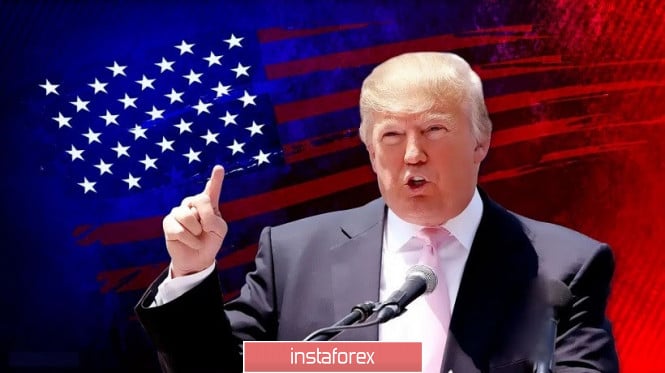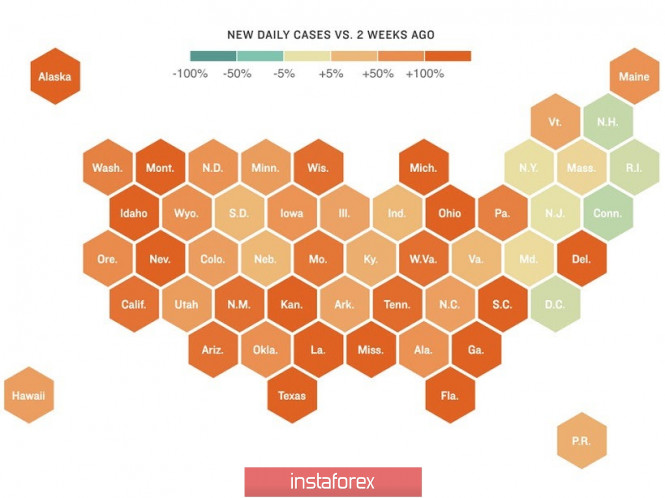The dollar index shows conflicting dynamics, reacting to varied fundamental background. On the one hand, the coronavirus factor exerts pressure on the greenback - an increase in the number of infections in the United States has prompted several states to stop lifting restrictions and change the terms of easing. On the other hand, US President Donald Trump continues to remain calm, claiming a reduction in mortality from COVID-19. On the one hand, risk appetite increased in the foreign exchange market amid growing key macroeconomic indicators in the US and Europe. On the other hand, yesterday's announcement by North Korea to abandon negotiations with Washington alarmed market participants. In addition, amid difficult relations with China, the United States sent two aircraft carriers to the South China Sea to conduct exercises. Beijing reacted negatively to this decision by the Pentagon, and this fact reduced investor interest in risk.
Such a varied fundamental picture does not allow dollar bulls to develop another offensive. However, the downward movement of the dollar index is limited. By and large, the US dollar index continues to fluctuate in the flat range of 96.6-97.6, within which it has been located since the beginning of June.
Let's start with the coronavirus. This is indeed the # 1 topic for dollar bulls - medical reports from the United States play no less significant role than macroeconomic reports. The White House's reaction to published statistics, in the context of a possible return to the nationwide lockdown, is also in the spotlight. Recent events and comments on this subject carry conflicting signals.

According to the latest data, the daily growth rate consistently exceeds the 40,000 mark. New cases of coronavirus infection were detected in the United States on July 4. The figure reached 57,497, which was the largest daily increase in cases since the beginning of the pandemic. Against the background of such trends, there were suggestions that the country will again be closed for quarantine with all the consequences that follow from this. But the White House is showing its equanimity. First, Trump recently said that the death rate from COVID-19 in the country has decreased by 39% compared to the peak of the epidemic. In his opinion, the media is "silent about the success in the fight against the epidemic." Secondly, he believes that educational institutions should open in the fall – he does not see any threats in this. Moreover, in his opinion, the Democrats, led by Joe Biden, want to use school closures for political purposes in the presidential election. In other words, Trump clearly does not intend to close the country to quarantine, and the issue of repeated lockdown is considered in a political context, in the aspect of the upcoming presidential elections.
However, if the rate of spread of the coronavirus continues to increase, the quarantine may be tightened at the local level. Such measures were called for, in particular, by the leaders of Austin and Houston — the largest cities in the state of Texas, which found a record number of new cases of the virus in a day — 8,258.
As we can see, the coronavirus factor is not unambiguous, given the position of the American President. But the dollar will be under strong pressure again if the daily growth rate increases and steadily exceeds the 50,000 mark.
If we consider the influence of the external fundamental background, it is also not so clear. On one side of the coin is the positive dynamics of many macroeconomic indicators, both in Europe and in the United States. For example, the German industrial order volume published yesterday came out of negative territory (where it had been for the previous three months) and reached a ten percent increase on a monthly basis. For comparison, there was a decline of almost 30% in the previous month. We were also pleased with US data: the ISM composite index for the non-manufacturing sector came out in the green zone, rising to 57 points in June. The indicator shows an upward trend for the second consecutive month. Also published yesterday was the PMI in the UK construction sector, which was also much better than expected. All these signs of recovery in the world's key economies have provoked increased demand for risky assets, the euro in particular. In turn, the dollar, which was used by the market as a protective asset for almost the entire spring, was again left without proper attention of investors.
However, the risk appetite slightly eased in the second half of Monday. The fault lies in North Korea. Let me remind you that on Sunday, the president of South Korea made a proposal to hold a meeting between Trump and Kim Jong-un before the US presidential election in November in order to resume negotiations on nuclear disarmament. Yesterday, the reaction of the DPRK followed: according to a representative of their foreign ministry, North Korea "does not intend to negotiate with Washington." At the same time, he added that relations between the countries are becoming "more complicated and sad".
However, this fundamental factor is unlikely to have a long-term impact. Pyongyang makes such statements with relative regularity, while the fact of the uneasy relations between the US and North Korea has long been known to everyone.
Thus, despite the contradictory fundamental picture, the dollar retains the potential for its further weakening – especially if the number of infected people in the United States increases at an accelerated pace. Trump's equanimity is explained by political reasons – if he repeatedly closes the country to quarantine, he will personally sign a loss in the election. But if the daily increase is consistently higher than the 50,000 mark, the dollar will inevitably be under pressure, in anticipation of stricter quarantine restrictions at the federal level.

Speaking directly about the EUR/USD pair, the bulls managed to gain a foothold above 1.1260 - the middle line of the Bollinger Bands indicator on the daily chart, which coincides with the Tenkan-sen line. In turn, the Ichimoku indicator formed a bullish Parade of Lines signal. All this indicates the priority of longs to the first resistance level of 1.1360 - this is the upper line of the Bollinger Bands on the same timeframe.
The material has been provided by InstaForex Company - www.instaforex.com